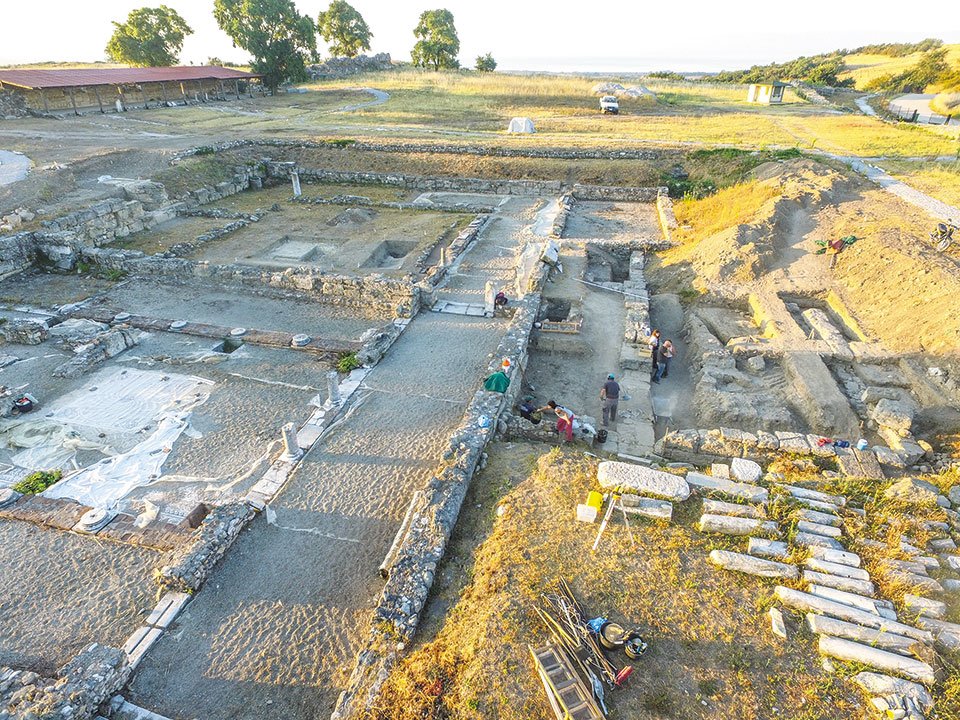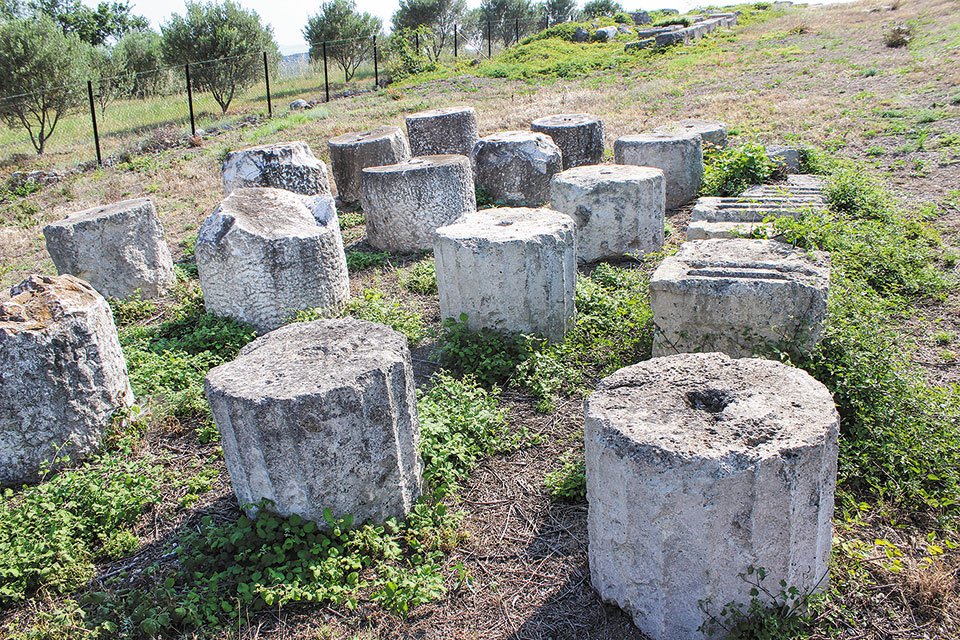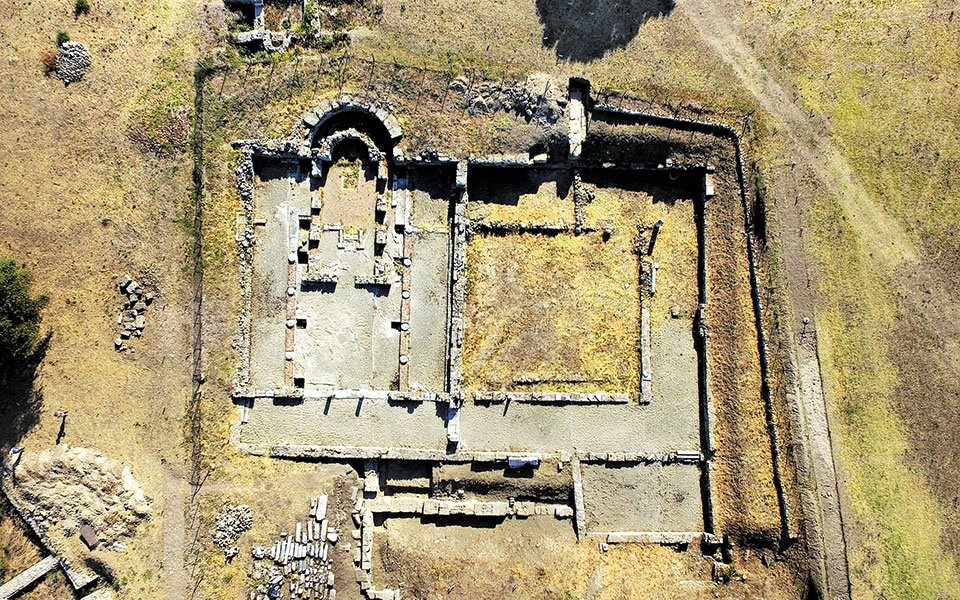There is more to Amphipolis than the Kasta Tomb, the largest tumulus (burial mound) yet discovered in Greece. That exciting discovery rightly took center stage when it was announced in 2014, with frenetic news coverage and the politicization of the find, resulting in a dramatic increase in visitors to the on-site archaeological museum.
However, even discounting this unique structure still under study by the scientific community and as yet not accessible to the general public, Amphipolis is an important archaeological site that, off and on, has been under excavation for many years.
The center of the site hosts the ruins of the ancient city, featuring impressive walls that span 7.5 km and various structures or items of interest scattered across the site: wooden poles – the supporting columns of the wooden bridge that crossed the Strymonas River during classical times; the finest and best-preserved gymnasium in Greece; and a section of a Hellenistic residence with intensely-colored wall paintings, similar to those found in Roman Pompeii.

© Ephorate of Antiquities of Serres - Ministry of Culture
The acropolis, located a few kilometers from the Kasta Tomb, is of particular archaeological interest. The strategic importance of the city is understood here; according to Thucydides, the Athenians were intent on controlling the Strymonas River region. The choice of location for the city (founded 437 BC) ensured complete control of a river that connected the coastal areas with the Thracian mainland, and dominion over the imposing Pangaion Hills and their gold and silver mines.
The archaeological site excavated by archaeologists from the past two years is a palimpsest. The Byzantine monuments and inner walls of the acropolis, excavated in the 1960s and 1970s by the Archaeological Society at Athens, are clearly visible to visitors today.
The site is characterized by four early Christian basilicas with impressive floor mosaics and an additional octagonal structure that was perhaps the bishop’s cathedra; it is, however, the wall surrounding these structures that is rather special.
“When I visited the acropolis in 2018 with Dimitria Malamidou, director of the Ephorate of Antiquities of Serres, following her invitation to work on a five-year research project, I was impressed by the plethora of repurposed architectural materials. The re-use of older sections of buildings no longer in operation is a common practice of the late Roman period, during which time sections of the fortifications of Amphipolis were completed,” says Dimitris Damaskos, Professor of Classical Archaeology at the University of Patras, who has been involved in researching ancient Macedonian sites for the past twenty years.

© Ephorate of Antiquities of Serres - Ministry of Culture
The pre-Christian city
Building material from Classical, Hellenistic and Roman buildings has been found in the newer structures, but it’s also been revealed by excavation work – shafts of Doric columns, triglyphs and metopes, bases with inscriptions – all of which formed part of the now-visible remnants of a pre-Christian settlement. But what do we actually know about ancient Amphipolis, the city that extended to the top of the hill?
“Archaeologically, very little,” Damaskos explains. “Surviving inscriptions and literary accounts suggest the core of Amphipolis was mainly composed of political and religious buildings. Some of these are located under the ruins of the Christian structures.”
Archaeologists involved in the current five-year research program (2019-2023), organized by the Ephorate of Antiquities of Serres and the University of Patras, are attempting to reveal the pre-Christian secrets of the Amphipolis acropolis.
Present-day excavations used partially excavated buildings from previous work as their starting point. The remains of a large Hellenistic building, clearly of public use, has been located under the early Christian structure Basilica C, a structure that was built using mainly ancient building materials.
The architectural and photographic documentation of the different sections of this building has proved a demanding task requiring financial support. The project will, however, yield important information, Damaskos says, about the “buildings located in the center of ancient Amphipolis during the time of Alexander the Great, as he began his campaigns towards the East from here, as well as important information regarding Philip V of Macedon, who lived here for many years until his death in 179 B.C. The Roman Emperor Augustus is also credited as the savior and builder of the city, yet we do not know exactly how he came to acquire these accolades.”
The results of the past two years of research were presented on Thursday, April 22, by the excavating team (Dimitria Malamidou, Dimitris Damaskos, Christina Athanasiou and Eleftheria Eleftheraki), on the occasion of the 33rd annual three-day meeting on archaeological projects in Macedonia and Thrace.
This year, all presentations took place via the internet, making it the first time since these meetings began that archaeologists did not gather on the premises of the Faculty of Philosophy at the Aristotle University of Thessaloniki to share the findings from their excavations.
This article was first published in Greek on kathimerini.gr.












